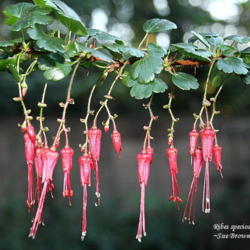Valuable source of nectar and pollen for honey bees.

Native in the Pacific Northwest west of the Cascade Range from British Columbia to California. Found in dry open woods, rocky slopes, and disturbed sites. Erect unarmed shrub with reddish-brown bark, gorgeous clusters of reddish-pink flowers in early spring. Small blue-black berries are edible but insipid - leave them for the birds. Can propagate from cuttings. Provides nesting sites for birds and small mammals.

Valuable source of nectar and pollen for honey bees. It is also a source of honeydew for honey bees.

I'd never seen a gooseberry, but a friend loves them and talked me into getting a couple. I got enough berries the very first year to know I wanted more! I harvest once they start to blush a little for a sweeter flavor. They make delicious pies! I use them in place of green grapes in recipes, too.

This European species of currant has been somewhat commonly planted in the Chicago, Illinois region; offered by a good number of conventional nurseries. It is a plain, reliable species of shrub that is often used for lower hedges, sheared or not sheared, or a group of medium height shrubs. It is mostly used by landscape designers rather than the general public. In the ornamental nursery trade, it is really the male clones that are used, and I have never seen any female clones that might produce some red berries. The biggest reason for this is that currants and gooseberries (Ribes) are the alternate host for the White Pine Blister Rust Disease that is a destructive fungus disease on the Eastern White Pine in more northern latitudes as northern Wisconsin & Minnesota & Michigan, New England, and southeast Canada. The male form of Alpine Currant is not a host to this disease. it is a nice looking medium-sized shrub with nice foliage that only develops a pale yellow fall color. It is often used as a sheared lower hedge. I have never seen it used in the Philadelphia, PA region.

Valuable source of nectar and pollen for honey bees. They also get honeydew from this plant.

Valuable source of nectar and pollen for honey bees. They also get honeydew from this plant.

Valuable source of nectar and pollen for honey bees. It also provide them with honeydew.

The Hopi name for this plant is "Yowípsi".

An important 'bird food' plant.
